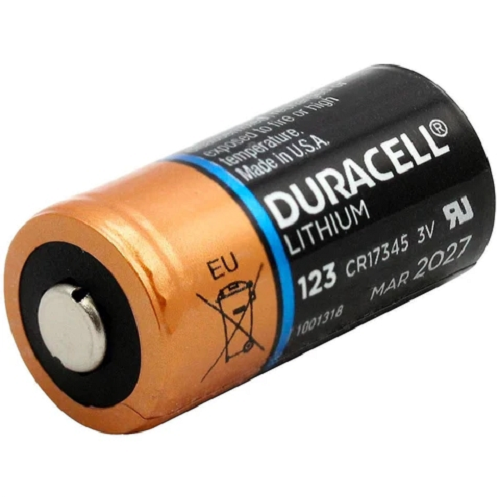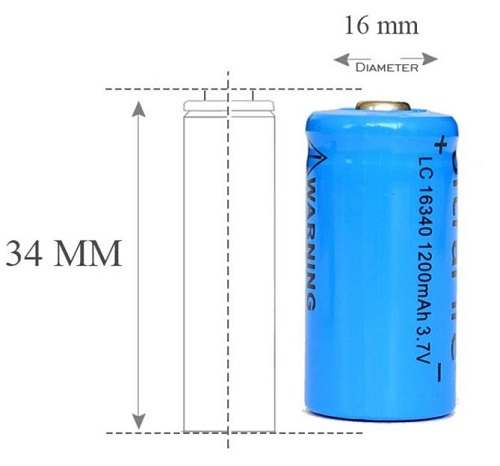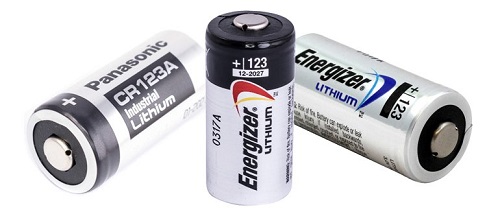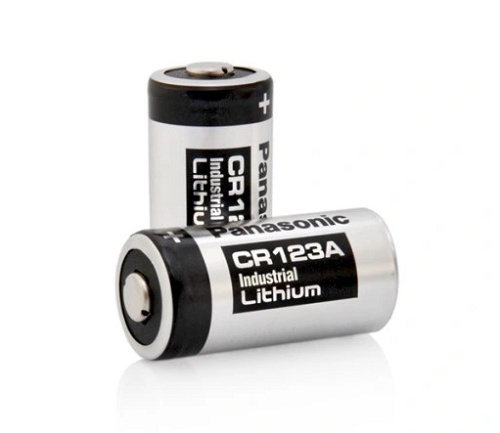CR123 vs CR123A batteries: which is better?
When exploring the world of CR123 and CR123A batteries, we delve into the realm of high-energy-density lithium batteries and uncover their significance in modern technology. This article offers an in-depth analysis of the definition, application, characteristics, and pivotal role of CR123 and CR123A batteries in various devices. Starting with the basic composition of the batteries, the article explores their technical specifications and applications and compares the subtle differences between CR123 and CR123A batteries.
1. Definition and Application of CR123 Batteries
2. Characteristics and Application Areas of CR123A Batteries
3. Comparison of CR123 and CR123A Batteries
4. Chemical Composition and Safety Features of CR123 and CR123A Batteries
5. Advantages and Disadvantages of CR123 and CR123A Batteries
6. Adaptation and selection of CR123 and CR123A batteries
7. Conclusion
1. Definition and Application of CR123 Batteries

CR123 batteries, diminutive yet potent 3V lithium powerhouses, are indispensable in modern electronics, distinguishing themselves in a myriad of applications. Their unique chemical composition and design advantages set them apart. These batteries, embracing lithium manganese dioxide (LiMnO2) as their cathode material, are celebrated for their high energy density and stable discharge traits. Their structure? A compact, cylindrical form, measuring about 17mm across and 34.5mm in height, facilitates effortless integration, even in space-constrained devices.
Predominantly, you'll find CR123 batteries in security alarms, portable flashlights, and a variety of camera models. They're the champions of stability and continuity in energy output. Typically, their energy capacity spans from 1,500mAh to 2,500mAh. This range enables prolonged power support, even amidst high-load demands. Furthermore, these batteries are adept at handling continuous currents ranging from 1,000mA to 2,000mA, a boon for high current-needing devices like bright flashlights. Pulse currents? They excel there too, handling up to 3,000mA, vital for instant high-power needs, such as activating a camera flash.
A deeper dive into the mAh ratings of CR123 batteries unravels a story beyond mere electricity provision. It's a tale of endurance against varying loads. Picture this: a 1,500mAh CR123 battery. In theory, it can sustain a 100mA device for 15 hours (1,500mAh / 100mA = 15 hours). But, the real-world scenario might differ slightly, thanks to efficiency losses during discharge. This blend of durability and efficiency crowns CR123 batteries as ideal contenders for a plethora of household and commercial uses.
2. Characteristics and Application Areas of CR123A Batteries

CR123A batteries, small yet mighty in high-voltage batteries, are the go-to choice for devices thirsting for high energy. Their compact stature and robust power output are unmatched. They shine in applications where energy is consumed voraciously - think high-performance LED flashlights, digital cameras, and a plethora of portable electronic devices. These applications crave not just energy but rapid, efficient delivery of it, a demand these batteries meet with ease.
In the ever-evolving world of electronics, where devices shrink yet grow more powerful, CR123A batteries are a perfect fit. They are meticulously crafted: about 33.4mm in length, 17mm in diameter, and weigh a mere 17 grams. Small? Yes. Insignificant? Far from it. Their diminutive size and feather-like weight make them a breeze to carry. More importantly, they meld seamlessly into the heart of various compact devices, enhancing rather than hindering design and user experience.
Energy capacity? CR123A batteries boast a range from 1,500mAh to 2,500mAh. This signifies their prowess in providing stable, enduring power for devices with insatiable current appetites. They excel particularly in the 1,500mA to 2,500mA continuous current range. Their performance is stellar. When it comes to pulse currents, they withstand up to 3,000mA, essential for those moments that demand a sudden surge of energy, like in flash photography.
CR123A batteries' prowess doesn't falter, even when the mercury drops. They thrive in the cold. Their chemical properties ensure they perform reliably, even in the teeth of sub-zero temperatures. This makes them a trusted ally for outdoor devices (envision mountaineering flashlights) and equipment in extreme conditions (such as specialized scientific instruments).
In sum, CR123A batteries are a harmonious blend of portability, energy density, stability, and adaptability to extreme conditions. They stand as a paragon of power sources for a multitude of demanding devices.
3. Comparison of CR123 and CR123A Batteries

When delving into the nuances between CR123 and CR123A batteries, their similarities are evident, yet subtle distinctions deserve attention. Firstly, let’s consider size. Both battery types embrace a compact, cylindrical design, ideal for small, high-power-needing devices like high-output LED lights and sophisticated photographic gear. The CR123 is typically a tad longer than its CR123A counterpart, with a marginally smaller diameter. However, this size difference is often slight, rarely impacting compatibility in a significant way.
Battery life? Both variants boast a lithium-based chemical composition, offering an impressive shelf life of up to 10 years – crucial for devices requiring extended storage or sporadic use. Yet, the real-world lifespan varies. It hinges on factors like the power draw of the device, how often it’s used, and the battery's discharge traits. For example, in a low-drain alarm system, these batteries might endure up to five years. Contrast this with their use of power-hungry LED flashlights, where their life expectancy understandably shrinks.
Voltage-wise, both the CR123 and CR123A offer a standard nominal voltage of 3 volts, typical when fresh out of the pack. In everyday use, expect them to function between 2 and 2.5 volts under normal loads, a trait ensuring stable device performance. Impressively, even as they near their discharge end, they maintain a fairly consistent voltage, underpinning device reliability.
Beyond these aspects, there are finer points: variations in discharge curves, internal resistance, and temperature adaptability. These nuances play a pivotal role in a battery's performance across different devices and environments. For instance, some brands or models are tailored for extreme temperatures or high-current scenarios, factors that guide users in their choice of battery type.
4. Chemical Composition and Safety Features of CR123 and CR123A Batteries

CR123 and CR123A batteries, while similar in many aspects, exhibit some subtle yet noteworthy differences, particularly in their chemical makeup and safety mechanisms. From a chemical standpoint, both battery types leverage lithium-based electrolytes within a lithium-manganese dioxide (LiMnO2) system. The crux of this system's advantage? It offers an exceptionally high energy density. To put numbers to it: about 280 watt-hours per kilogram and 580 watt-hours per liter. This means they pack a substantial energy punch in a compact, lightweight package – a boon for small electronic devices craving long-term operation or high-power output.
Delving deeper, these batteries' cathodes (the positive terminals) are crafted from specially heat-treated manganese dioxide. Heat treatment does more than just stabilize the material; it also boosts its efficiency in reacting with lithium ions. The result? Enhanced performance and prolonged battery life. This chemical architecture ensures the batteries maintain a stable voltage output during discharge, minimizing energy loss.
Safety-wise, handling lithium batteries does require caution due to lithium's high reactivity, which under certain conditions, can be hazardous. Overheating, short-circuiting, or mechanical damage can trigger internal chemical reactions, sometimes escalating to fires or explosions. To mitigate these risks, both CR123 and CR123A batteries incorporate PTC (Positive Temperature Coefficient) protection. This clever mechanism automatically interrupts the current in case of excessive heat or abnormally high current, thwarting potential dangers from overheating or short circuits.
Moreover, these batteries feature additional safety measures. Think built-in safety valves, ready to release gas if internal pressure skyrockets, thus averting bursting or explosion scenarios. The battery casings themselves are engineered to endure high pressure and prevent leaks, safeguarding their use in everyday scenarios.
5. Advantages and Disadvantages of CR123 and CR123A Batteries
In terms of capacity, CR123A batteries typically flaunt a superior reservoir, translating into an extended lifespan when juxtaposed with their CR123 counterparts. Voltage, a pivotal consideration, diverges between these two variants: CR123 batteries dispense around 3V, while CR123A batteries proffer an approximate 3.7V. This dissimilarity in voltage stands as a pivotal determinant when electing batteries for specific devices.
Moving on to size and compatibility, CR123A batteries tend to be marginally thicker than CR123 batteries. Consequently, compatibility is not a given – certain devices are tailored to embrace solely one of these classifications. Hence, an imperative advisory: meticulously verify interoperability before consummating any purchase.
On the cost front, CR123A batteries might induce a modest dent in your financial reservoir compared to CR123 batteries. However, thanks to the increased battery capacity, the initial financial imbalance can be offset over a longer period of use.CR123A batteries relish more extensive usage and acclaim, rendering them more promptly accessible in the marketplace, unlike the relatively CR123.
In summary, the choice between CR123 and CR123A batteries pivots on the specific requisites of your device and your idiosyncratic predilections. To ensure the most felicitous fit, consulting the user manual or communicating with the device manufacturer for counsel on the most suitable battery type for your application is highly recommended.
6. Adaptation and selection of CR123 and CR123A batteries

Exploring the adaptability and array of CR123 and CR123A batteries requires a nuanced understanding that, notwithstanding subtle nomenclatural distinctions attributed to diverse manufacturers' nomenclature norms, these batteries exhibit a noteworthy congruence in terms of functionality, efficacy, longevity, and chemical composition. They virtually function interchangeably in devices supporting either variant. Both battery classifications are meticulously crafted for high-performance electronic apparatus. Their forte lies in meeting the rigorous demands for energy density and power output inherent in devices such as digital cameras equipped with flash capabilities and sophisticated LED flashlights. In such applications, CR123 and CR123A batteries distinguish themselves by swiftly providing potent energy output, all the while maintaining enduring reliability and stability.
When navigating the battery selection process, users must recognize that, notwithstanding the near-identical dimensions and performance attributes of these two types, ensuring the specific compatibility of their devices with a particular battery is imperative. Distinct battery manufacturers may manifest divergences in certain non-standardized performance facets, encompassing discharge curves, temperature adaptability, or safety features. Notably, specialized applications may necessitate batteries that function optimally in exceptionally low temperatures or offer augmented safety protocols, underscoring the importance of selecting the apt battery model.
Despite the disparate nomenclature adopted by brands such as Energizer and Duracell (e.g., Energizer's 123 versus Duracell's CR123A), this primarily reflects commercial branding strategies rather than signaling substantive technical disparities. Consumers are better served by focusing on the batteries' specifications and performance parameters, aligning them with their specific device requirements, instead of being swayed solely by the brand appellation.
7. Conclusion
After a thorough exploration of CR123 and CR123A batteries, we can conclude that although these two types of batteries are very similar in size, performance, and chemical composition, they play different roles in specific application scenarios. Simultaneously, we recognize that when choosing batteries, one should consider the specific needs of the device and the characteristics of the batteries to ensure the selection of the most suitable type.
FAQ
What Does CR Stand For?
Can Rechargeable and Non-Rechargeable CR123A Batteries Be Interchanged?
If you do so, it won't damage your device; however, rechargeable and non-rechargeable batteries may have different voltages and capacities. Additionally, the sizes might differ slightly. Some devices may only function properly with one or the other, so check the specifications of your device before switching.
Are All CR 123A Batteries the Same?
In terms of specifications, all 123A batteries have the same basic features. However, each manufacturer might add different features and aesthetics to distinguish their products. For most well-established brands, such as Panasonic, Energizer, Duracell, or Duracell CR123A equivalents, you should not notice any difference. However, if the battery is not made in the USA, it might differ from the standard 123, so be sure to check the manufacturer's information.